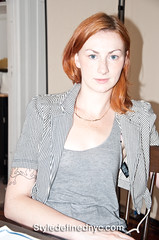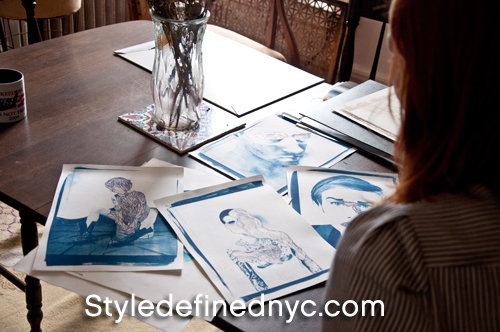
I recently sat down to talk with Danielle Ezzo. I’d met her briefly at Distorted Beauty, a photography exhibition she curated, that explores and questions the long-seated practice of transforming the photographic image through digital manipulation –especially in the fashion and beauty industries. She is also an artist/photographer in her own right and her work has been profiled in Time Out, Next Magazine, Aventura, The L Magazine, Out Magazine, Guanabee, Gawker, MF Magazine, among others. As well as exhibited locally at the Like, the Spice Gallery, SOHO House, Papa B Studios, Shadow’s Space, the ISE Foundation, and Fuse Gallery.
Danielle is currently working on a series of images that have as the starting point the photographic image, but the image is altered in an entirely different way: through drawing on with ink to create a new visual that seems to hover between the internal and external worlds of the people in the work.
Read my interview with her below.
First of all, I have to say I think these are gorgeous images that seem delicately visceral…if that’s possible! I’m stunned by the ambiguity and struggle in these images. What part of your brain did they come from?
(laughs) Yes, well… some of my work is mildly grotesque, but in subtle more subversive ways. They aren’t that gross necessarily. Specifically these are studies in the process of healing. My subjects are all people in my life that I’ve gone through things with. It touches on the process of breaking up or dealing with challenging things and how we heal or change from. A lot of my work deals with the interpersonal relationships and the psychology of people.
Do they know that? That they’re subjects in your artwork then?
Yes, they do. (laughter) . They do. Half of these, I met through other people, asked to photograph them, and eventually we became friends. Then these other photos were reworked for this project specifically.

You’re the co-curator of a gallery.
For the past two years I’ve been curating with Samantha Levin under the name Anagnorisis – a company that we started together. I just recently left– she’s still going on – supporting, representing and curating for artists of a similar aesthetic – pop surrealism, that sort of thing. But other than that, I also curate for Art + Culture magazine looking for emerging photographers, mixed-media artists of a darker nature. All things subtle, subversive, sublime.
These are really interesting. Can I ask you about the technical aspects?
The images you’re looking at called cyanotypes, which utilize a contact negative process. Basically you have to have the negative right on the piece of paper so the size photograph is restricted by the size of the negative. I’m trying to devise alternatives to create larger artworks with the same process. One way would be by attaching negatives together - like a collage of sorts – that’s where my head is at. I’m also exploring some other alternative photo processes, but it too early to tell what will happen with that right now.
How do you think about making work? Is it random or do you have a specific notion?
Creating a body of work is like creating little science experiments about life. I choose a question I want an answer to - research, create a hypothesis, and the experiment is making the work. Through trial and error I slowly get closer to the answers I sought out. I love the nature of scientific thought - my artwork brings me closer to that.

What’s the most challenging thing about your work?
I would say the space in which I work is problematic. I don't have a suitable area in my apartment to set up a mini darkroom, so I currently work out of a friend's space. Ultimately, I just need my own studio to make my own mess.
Who are three people who have been inspirational in your creative process and why?
There's so many. I find inspiration in the most unusual places. Here's a few though:
• Dan Estabrook - whose studio I work out of. He is an incredibly talented photographer, friend, and mentor to me in so many ways.
• Sandy Skoglund - One of the first photographers I really fell head over heels for. The complexity of her photos are astonishing.
• Jennifer Charles - She's the singer for Elysian Fields and the once project band, Lovage. Her voice is enchanting, dark, and sultry. I could only hope to have my work translate visually like her work translates vocally.
Where did you grow up and why do you choose to be in New York?
I hail from a small rural town in New Jersey and I moved around quite a lot growing up, but was never too far away from NYC. Surprisingly enough, I wasn't at all interested in visiting New York as a kid. I ended up studying art in Savannah, GA. Not at all like any city I was used to, but it was completely the right decision at the time. My reason for moving to New York was partially an impractical one. I fell crazy in love with a furniture graduate and he ended up getting work here. I'm notorious for leaving, and have always found romance in getting lost. In fact, I seek it out. Thankfully, it ended up being the perfect place for me to be.
Do you feel like NYC is still creatively on the edge, or has it been surpassed?
It's hard for me to say because I've only been living here for the past five years. Creative people make work regardless of where they live. In New York, the biggest issue is money. The economic state of the country coupled to the ever rising cost of living makes it incredibly difficult - whether you’re an artist or not. Last year I was fed up and bought a one way ticket to Berlin. The buzz was that Berlin was like New York in the ‘80s – a tight arts community where it was easier to live and work and make work. And it tempted me but there’s that something about here that continually draws me back. Maybe it's the creative edge, or perhaps I'm just a glutton for punishment.
Beyond punishment, what inspires you about the City?
I like a challenge, and I tend to push myself harder when life pushes back a little. I need obstacles to keep me thinking and on my toes. This tends to make me cranky and frustrated, but there is something about this type of stimulation that keeps my creativity flowing.
This current body of work will be printed on clothing produced by Seasick Mama through their Preserving Visual Arts in Fashion Program. This project will run for 52 weeks, 52 artists for every week of the year. At the end of it all, Seasick Mama will have an entire collection of New York Cities most recognizable and fashionable artists, which will then be showcased to the public as an exhibit. Why did you decide to put your work on a t-shirt?
I like the idea of exploring where fashion and art meet. It's also important to make art affordable at times. The idea of having your work in galleries, museums, and immersing yourself in the "high" art world is ok, but I think it's equally as important to share your work with as many people as possible. This is especially important as a young artist such as myself. I want people to have the opportunity to enjoy my work, and I think that Seasick Mama has created a great strategy to do so.
Where are you heading in your work?
Well, damn... isn't that a loaded question! Um, hopefully not down the toilet! As much as I like exhibiting, recently the most important thing for me has just been focusing on the content on my work and solidifying a strong work ethic. I've always juggled between different mediums and art forms. This diversity enriches my creativity, but I'm at the point where I mostly just want to be in the darkroom all the time. Where am I heading? Hell if I know –but at least I’ll be taking pictures along the way.
How do the photographers in your family influence you? Or do they?
Well, unfortunately not many of them shoot much anymore. When I was young, I looked up to my Aunt Susan. She played around with some of the older processes that I now use, but mostly she enjoyed incorporating other media into her works. I have no doubt that sparked something inside me.
And as a follow up to this – are they supportive, inspiring, collaborative?
For the most part, my family is very supportive. Sometimes (maybe often) they don’t understand how I'm supporting myself, and they worry like parents do. But they have the same concerns I have for myself. For me, it's all about embracing instability and craving my own path regardless, how difficult. You have to take the good with the bad.
What’s the best advice ever given or received?
Photograph every day. Photo by photo. Regardless, how poor you think it is... Get it out. It's all part of a very necessary process.




No comments:
Post a Comment